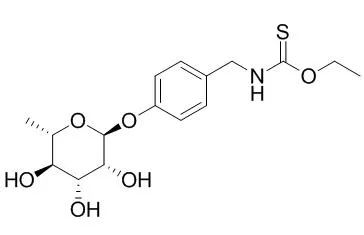| In vitro: |
| Pak J Pharm Sci. 2014 Mar;27(2):397-403. | | Review: an exposition of medicinal preponderance of Moringa oleifera (Lank.).[Pubmed: 24577932] |
METHODS AND RESULTS:
Seeds have been pragmatic with active components as novel O-ethyl-4- (α -L-rhamnosyloxy) benzyl carbamate together with seven known compounds, 4 (α -L-rhamnosyloxy)-benzyl isothiocyanate, Niazimicin, niazirin, β-sitosterol, glycerol-1- (9 -octadecanoate), 3 -O- 6 -O-oleoyl- β -D-glucopyranosyl-b-sitosterol, and β - sitosterol- 3-X-O -β -D-glucopyranoside , that have been discerned to inhibit EBV-EA (Epstein- Barr virus-early antigen), that is persuaded by the cancer promoter.
CONCLUSIONS:
M. oleifera leaves, gums, roots, flowers as well as kernels have been unanimously utilized for managing tissue tenderness, cardiovascular and liver maladies, normalize blood glucose and cholesterol. It has also profound antimicrobial, hypoglycemic and anti-tubercular activities. | | J Gen Appl Microbiol. 2014;60(6):251-5. | | Synergistic antimicrobial efficacy of mesoporous ZnO loaded with 4-(α-L-rhamnosyloxy)-benzyl isothiocyanate isolated from the Moringa oleifera seed.[Pubmed: 25742976 ] | The antimicrobial activities of isolated compounds from seed extracts of Moringa oleifera and synergistic antimicrobial efficacy through hybridized complex of organic-inorganic composite materials were studied.
METHODS AND RESULTS:
The two main components of the Moringa oleifera seed were isolated and determined to be Niazimicin and 4-(α-L-rhamnosyloxy)-benzyl isothiocyanate (RBI). The antimicrobial activity of the separated compounds of the Moringa oleifera seed were tested in vitro against 3 bacterial species and 2 fungal species by the paper disc diffusion assay and broth dilution methods.
CONCLUSIONS:
Both compounds showed antimicrobial activity against tested species and RBI was more effective than Niazimicin.
The MIC of RBI on S. aureus, E. coli, P. aeruginosa, C. albicans, and A. niger was 0.005%, 0.1%, 0.5%, 0.5%, and 0.5%, respectively, while the MIC of Niazimicin on S. aureus was 0.1%. | | Mutat Res. 1999 Apr 6;440(2):181-8. | | An antitumor promoter from Moringa oleifera Lam.[Pubmed: 10209341] |
METHODS AND RESULTS:
In the course of studies on the isolation of bioactive compounds from Philippine plants, the seeds of Moringa oleifera Lam. were examined and from the ethanol extract were isolated the new O-ethyl-4-(alpha-L-rhamnosyloxy)benzyl carbamate (1) together with seven known compounds, 4(alpha-L-rhamnosyloxy)-benzyl isothiocyanate (2), Niazimicin (3), niazirin (4), beta-sitosterol (5), glycerol-1-(9-octadecanoate) (6), 3-O-(6'-O-oleoyl-beta-D-glucopyranosyl)-beta-sitosterol (7), and beta-sitosterol-3-O-beta-D-glucopyranoside (8). Four of the isolates (2, 3, 7, and 8), which were obtained in relatively good yields, were tested for their potential antitumor promoting activity using an in vitro assay which tested their inhibitory effects on Epstein-Barr virus-early antigen (EBV-EA) activation in Raji cells induced by the tumor promoter, 12-O-tetradecanoyl-phorbol-13-acetate (TPA).
CONCLUSIONS:
All the tested compounds showed inhibitory activity against EBV-EA activation, with compounds 2, 3 and 8 having shown very significant activities. Based on the in vitro results, Niazimicin (3) was further subjected to in vivo test and found to have potent antitumor promoting activity in the two-stage carcinogenesis in mouse skin using 7,12-dimethylbenz(a)anthracene (DMBA) as initiator and TPA as tumor promoter. From these results, Niazimicin (3) is proposed to be a potent chemo-preventive agent in chemical carcinogenesis. |
|






 Cell. 2018 Jan 11;172(1-2):249-261.e12. doi: 10.1016/j.cell.2017.12.019.IF=36.216(2019)
Cell. 2018 Jan 11;172(1-2):249-261.e12. doi: 10.1016/j.cell.2017.12.019.IF=36.216(2019) Cell Metab. 2020 Mar 3;31(3):534-548.e5. doi: 10.1016/j.cmet.2020.01.002.IF=22.415(2019)
Cell Metab. 2020 Mar 3;31(3):534-548.e5. doi: 10.1016/j.cmet.2020.01.002.IF=22.415(2019) Mol Cell. 2017 Nov 16;68(4):673-685.e6. doi: 10.1016/j.molcel.2017.10.022.IF=14.548(2019)
Mol Cell. 2017 Nov 16;68(4):673-685.e6. doi: 10.1016/j.molcel.2017.10.022.IF=14.548(2019)